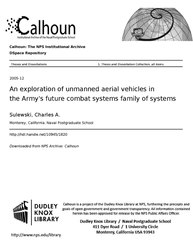File:An exploration of unmanned aerial vehicles in the Army's future combat systems family of systems (IA anexplorationofu109451820).pdf

Original file (1,275 × 1,650 pixels, file size: 3.03 MB, MIME type: application/pdf, 185 pages)
Captions
Captions
Summary[edit]
| An exploration of unmanned aerial vehicles in the Army's future combat systems family of systems
( |
||
|---|---|---|
| Author |
Sulewski, Charles A. |
|
| Title |
An exploration of unmanned aerial vehicles in the Army's future combat systems family of systems |
|
| Publisher |
Monterey, California. Naval Postgraduate School |
|
| Description |
Unmanned aerial vehicles (UAVs) will be a critical part of the U.S. Army's Future Force. The Future Force will be a highly mobile, network enabled family of systems with integrated sensors and precision munitions. The Future Force will rely heavily on UAVs to provide eyes on the battlefield. These eyes will trigger the deployment of precision munitions by other platforms, and possibly by UAVs themselves. To provide insight into how the numbers and capabilities of UAVs affect a Future Force Combined Arms Battalionâ s (CABâ s) ability to secure a Northeast Asia urban objective, a simulation was built and analyzed. 46,440 computational experiments were conducted to assess how varying the opposing force and the numbers, tactics, and capabilities of UAVs affects the CABâ s ability to secure the objective with minimal losses. The primary findings, over the factors and ranges examined, are: UAVs significantly enhance the CABâ s performance; UAV capabilities and their tactics outweigh the number of UAVs flying; battalion level UAVs, especially when armed, are critical in the opening phases of the battle, as they facilitate the rapid attrition of enemy High Pay-off Targets; and, at least one company level and a platoon level UAV enhances dismounts survivability later in the battle. Subjects: Ammunition; Drone aircraft; Operations research |
|
| Language | English | |
| Publication date | December 2005 | |
| Current location |
IA Collections: navalpostgraduateschoollibrary; fedlink |
|
| Accession number |
anexplorationofu109451820 |
|
| Source | ||
| Permission (Reusing this file) |
Approved for public release, distribution unlimited | |
Licensing[edit]
| Public domainPublic domainfalsefalse |
This work is in the public domain in the United States because it is a work prepared by an officer or employee of the United States Government as part of that person’s official duties under the terms of Title 17, Chapter 1, Section 105 of the US Code.
Note: This only applies to original works of the Federal Government and not to the work of any individual U.S. state, territory, commonwealth, county, municipality, or any other subdivision. This template also does not apply to postage stamp designs published by the United States Postal Service since 1978. (See § 313.6(C)(1) of Compendium of U.S. Copyright Office Practices). It also does not apply to certain US coins; see The US Mint Terms of Use.
|
 | |
| This file has been identified as being free of known restrictions under copyright law, including all related and neighboring rights. | ||
https://creativecommons.org/publicdomain/mark/1.0/PDMCreative Commons Public Domain Mark 1.0falsefalse
File history
Click on a date/time to view the file as it appeared at that time.
| Date/Time | Thumbnail | Dimensions | User | Comment | |
|---|---|---|---|---|---|
| current | 11:07, 14 July 2020 |  | 1,275 × 1,650, 185 pages (3.03 MB) | Fæ (talk | contribs) | FEDLINK - United States Federal Collection anexplorationofu109451820 (User talk:Fæ/IA books#Fork8) (batch 1993-2020 #7081) |
You cannot overwrite this file.
File usage on Commons
The following page uses this file:
Metadata
This file contains additional information such as Exif metadata which may have been added by the digital camera, scanner, or software program used to create or digitize it. If the file has been modified from its original state, some details such as the timestamp may not fully reflect those of the original file. The timestamp is only as accurate as the clock in the camera, and it may be completely wrong.
| Short title |
|
|---|---|
| Author | Ski |
| Date and time of digitizing | 13:09, 23 November 2004 |
| Software used | PScript5.dll Version 5.2.2 |
| File change date and time | 00:55, 12 December 2005 |
| Date metadata was last modified | 00:55, 12 December 2005 |
| Conversion program | Acrobat Distiller 6.0 (Windows) |
| Encrypted | no |
| Page size | 612 x 792 pts (letter) |
| Version of PDF format | 1.4 |

